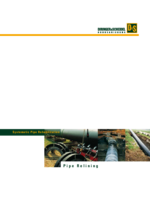The product
When laying gas and water pipes in accordance with DVGW Worksheet GW 320-1 (Edition 02/2009) "Renewal of gas and water pipes by pipe insertion or pipe insertion with annular space", a distinction is made between three methods: pipe string relining, long pipe relining and short pipe relining. According to the technical framework conditions of the respective process, pipes made of PE, GFK, PVC, steel or other materials such as cast iron are brought into the line to be rehabilitated. The selection of the process depends on the local conditions and the desired properties of the new pipeline.
The field of application
The pipe relining procedure (pipe run, long pipe and short pipe relining) can be used in the sector of gas, water and wastewater pipelines as well as in industrial pipelines for almost any kind of damage, wherever a reduction of the cross section of the existing pipeline is possible. Against a new pipe, the pipe relining creates a new fully functional pipeline in the cross section of the existing pipe.
The installation
Professional cleaning - for example mechanical, hydraulic or with maximum water pressure - creates the conditions for the smooth insertion of the new pipes into the sewer to be rehabilitated. With pipe strand relining, the pipes are first welded together to form a strand and then completely drawn in.
With long pipe relining, on the other hand, they are welded together in the installation pit and successively installed, while with short pipe relining (exclusively pressureless area) short pipe modules are individually inserted into the pipeline to be rehabilitated via the existing shafts. After the pipe has been drawn in, the remaining annular space can be filled with a dam. This contributes to a fixation of the inliner as well as to an even transfer of the external loads and the avoidance of cavities or drainage effects.
The advantages
Pipe relining stands for rational and economical rehabilitation. The process is suitable for all nominal diameters. Depending on the new pipe material, lengths of up to 1000m can be drawn in in one operation. The rehabilitation is carried out without any significant impact on road traffic or the environment. The result is a statically self-supporting and as good as new pipeline. The low cost of civil engineering work and the short construction period keep the overall costs low.
![[Translate to English:] Diringer & Scheidel Rohr [Translate to English:] Logo Diringer & Scheidel Rohr](/fileadmin/media/logos/DuS_Rohr_GmbH_u_Co_KG.svg)
